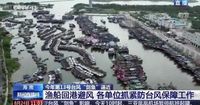Typhoon Kajiki, a powerful tropical storm, has unleashed chaos across southern China and parts of Vietnam, prompting mass evacuations, the closure of businesses, and widespread travel disruptions as both countries brace for its full impact. The storm’s approach on August 24, 2025, triggered a flurry of emergency measures in the popular Chinese resort city of Sanya and forced Vietnamese authorities to prepare for what they described as one of the most serious weather threats in recent memory.
According to China’s official Xinhua News Agency, Kajiki brought strong winds and heavy rain to Hainan island and nearby Guangdong province on Sunday, with about 20,000 people evacuated from areas deemed hazardous. More than 21,000 crew members of fishing boats were brought ashore as a precaution. The storm, packing maximum sustained winds of up to 166 kilometers per hour (about 103 miles per hour) by late Sunday morning, was expected to gain further strength as it tracked westward over the South China Sea.
In Sanya, a city renowned for its seafront resorts and sandy beaches, the local government moved swiftly. As reported by Reuters and Xinhua, officials closed tourist attractions, shopping centers, restaurants, and supermarkets. Public transport ground to a halt, and all classes and construction were suspended from Sunday onward. The city issued a red typhoon alert—the highest level in China’s warning system—and raised its emergency response to the most severe level. Posts on the local government’s WeChat account underscored the seriousness of the situation, urging residents to stay indoors unless absolutely necessary.
City officials convened an emergency meeting on Saturday evening, urging thorough preparations for “worst-case scenarios.” Their goal, as stated by the government, was clear: “heightened vigilance to ensure no fatalities and minimal injuries.” Videos posted by Guangdong Radio and Television captured the storm’s fury, with tree branches snapping and docked boats being rocked violently as waves crashed over piers.
Hainan, often described as China’s only true tropical beach destination, received over 97 million visitors in 2024, according to Xinhua. The arrival of Kajiki forced the shutdown of businesses and tourist sites across the island, particularly in Sanya, which is home to more than a million people and is a magnet for both domestic and international tourists. With over 30,000 fishing boats returned to port, the local economy—heavily reliant on tourism and fishing—was effectively put on pause.
China’s National Meteorological Center forecast rainfall of up to 400 millimeters (about 15.7 inches) in parts of Hainan, while the Sanya Meteorological Observatory warned of lightning, torrential rain, and gusts reaching 113 miles per hour. The storm’s impact was not confined to Hainan; nearby Guangdong province and the Guangxi region were also put on alert for heavy rain and strong winds.
Meanwhile, across the Gulf of Tonkin, Vietnam was preparing for its own battle with Kajiki. State media reported that authorities planned to evacuate more than 586,000 people from the central provinces of Thanh Hoa, Quang Tri, Hue, and Danang, where the typhoon was forecast to make landfall early Monday. Seven coastal provinces banned boats from leaving shore starting Sunday morning, and all vessels at sea were ordered to return to port. The Vietnamese government advised people in the projected path not to go outdoors after 1400 GMT on Sunday, and soldiers were placed on standby to assist with evacuations and emergency response.
Farmers in the city of Hue rushed to harvest their rice crops before the storm’s arrival, hoping to salvage what they could from the impending deluge. Authorities also called for the reinforcement of dykes, reservoirs, and irrigation systems to minimize the risk of flooding and crop destruction.
Air travel was hit hard: Vietnam Airlines, the country’s flag carrier, canceled at least 22 flights to and from central cities on Sunday and Monday, while Vietjet Aviation announced additional cancellations and delays. The disruptions left many travelers stranded and forced others to change their plans at the last minute.
Vietnam’s national weather forecast agency reported that Kajiki was about 500 kilometers (300 miles) off the central coast at 0600 GMT on Sunday, moving west at 20 kilometers per hour. The storm was expected to strengthen, with wind speeds potentially reaching 180 kilometers per hour (about 112 miles per hour) before landfall. The Vietnamese government compared Kajiki’s strength to that of Typhoon Yagi, which battered the country less than a year ago, killing about 300 people and causing $3.3 billion in property damage, as noted by Reuters.
Back in Sanya, the city’s response was shaped by recent experiences with extreme weather. Since July, record rainfall has lashed China’s north and south, with meteorologists attributing the surge in severe weather to climate change. Data from China’s Ministry of Emergency Management revealed that natural disasters—including flooding and drought—caused 52.15 billion yuan (about $7.28 billion) in direct economic losses in July alone, affecting millions of people and leaving 295 dead or missing.
The scale of the current evacuations in both China and Vietnam is staggering. The coordinated efforts—moving hundreds of thousands of people to safety, grounding flights, and shutting down entire cities—reflect the lessons learned from past disasters. Both governments emphasized the need for vigilance and preparation, with Chinese and Vietnamese officials repeatedly warning against complacency.
Not only are local residents affected, but the storms also threaten the tourism industries that are vital to both Hainan and Vietnam’s central coast. Sanya alone attracted 34 million tourist visits last year, according to Xinhua, and the city’s swift closure of attractions and public services underscores the priority given to public safety over economic activity. The Vietnamese provinces in the storm’s path, meanwhile, are home to important agricultural regions as well as popular tourist destinations like Hue and Danang.
Despite the extensive preparations, the human and economic toll of Typhoon Kajiki remains to be seen. As the storm barrels toward Vietnam’s coast, officials on both sides of the South China Sea are bracing for the possibility of flooding, wind damage, and further disruptions to daily life. The next 24 hours will be critical as communities hunker down, rescue teams stand ready, and authorities monitor the storm’s every move.
For millions in the region, Typhoon Kajiki is a harsh reminder of the growing challenges posed by extreme weather. With emergency plans in full swing and the memory of past disasters fresh in their minds, residents and officials alike are hoping that their efforts will be enough to weather the storm.





